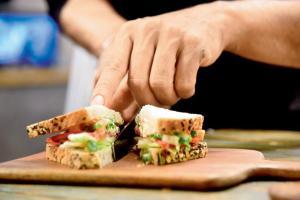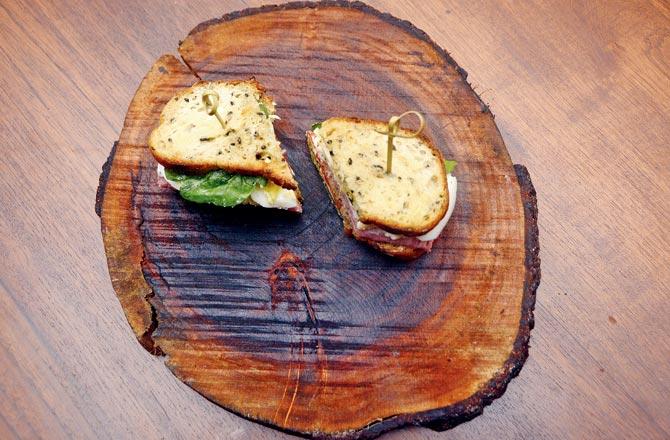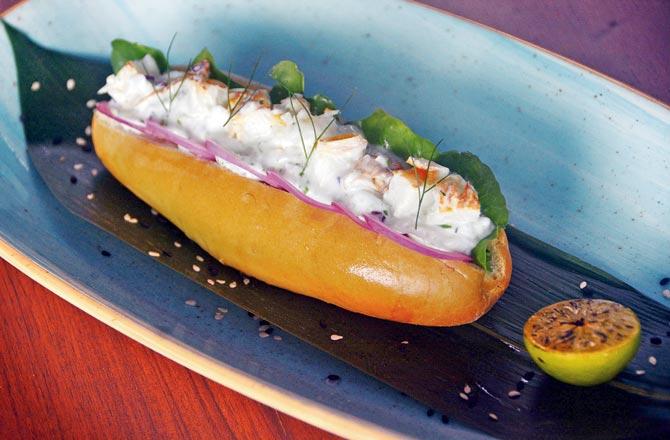What's the best way to slice a sandwich? If city chefs are to be believed, there's a science to this geometry, and it also has a role to play in how you relish your bite

Chef Ranveer Brar likes his sandwiches to have "sass". They need to be open—but not too exposed—and stuffed with fresh produce in a way that the ingredients entice him with each bite. "To put it simply, I like my sandwiches smiling at me," he says. But the secret to the smile lies in the way it is sliced. "How you cut the sandwich is an important component of the preparation. One that's been highly underrated."
ADVERTISEMENT
And it's not an OCD-propelled statement. Brar's fascination has takers in the city. Chef Rohan D'Souza, culinary director at Silver Beach Hospitality, believes that the sandwich cut plays a vital role in the balance of ingredients. "The cut determines the bite, as it helps bring out the dominant core ingredient the sandwich is based on. For example, in a chicken sandwich, the core ingredient is chicken, and the condiments are the enhancers." Until now, we considered the cut to be a quick finish to a slap-it-together meal. It turns out, there's a science to it, too.

A diagonally cut club house chicken sandwich, served at Estella in Juhu. Pic/Sneha Kharabe
Last year, a study by the Department of Culinary Science at The University of Vermont found that the way we cut our sandwiches has a direct impact on how much we enjoy them. In the experiment, participants overwhelmingly opted in favour of "cut sandwiches" over the uncut counterparts. Here, it was the diagonally-sliced one that stood out as the undisputed winner. Brar, who has been part of TV shows such as The Great Indian Rasoi, and MasterChef India, has enough material to support his argument.
"After we bake bread, we always cut it against the grain, which means when sliced perpendicular to the fibres, the bread becomes as tender as a cut of expensive meat." He compares the bread to a mesh and by cutting it against the mesh, we are tenderising it and making it easier to chew.

The English lobster roll is cut diagonally from the top of a soft brioche bun and the filling is mainly placed from the top. Pic/Sneha Kharabe
So, while all cuts are important, some are more. Chef Menino D'costa of Bandra's Caffè Ritazza, personally prefers to use the 'X' cut to serve sandwiches—two straight cuts from one corner to the opposite corner. "That way, it's easier to garnish and plate them. Also, it helps us display the stuffing inside." Here, the crust is on one side, catering only to those who like to eat the soft, sumptuous interiors. For D'costa, the cuts matter all the more, when it comes to preparing pass-arounds and the buffet. "The square cut is convenient for rotational serving."
If D'costa roots for X, Amit Sharma, chef and co-founder of Poetry by Love & Cheesecake, says that the diagonal cut reigns supreme. "There is more of a math advantage in cutting sandwiches diagonally. The cut helps maintain the overall structure of the sandwich up to lunch hour. The hypotenuse length also maximises the filling per bite eaten. Acute corners allow for four perfect initial sandwich bites. And the initial corner consumption sets up two ultimate bites of unmatched, crust-less perfection."

Chef Ranveer Brar prefers smacking the sandwich right in the middle. That way "you are technically exposing less" and the opportunity of the bread drying reduces automatically, he says. Pic/Sameer Markande
What's interesting is that every chef has his "type". If Sharma bats for diagonal, Brar has his reasons to refrain from it. His argument is that in the diagonal, you end up exposing more area because it's one side of the right angle triangle, which is longer than both sides. "By exposing it, you're allowing it to dry faster." He prefers to smack it right in the middle. That way "you are technically exposing less" and the opportunity of the bread drying is reduced.
Even before getting to the cut, Brar says that the two aspects, which can make or mar the sandwich are the quality of the filling and the quality of the bread. According to him, a great bread is tough enough to hold the ingredients, yet pliable. "While the filling will always vary, a lot of the responsibility lies on the bread, since it constitutes one half of the sandwich," he says. But it's not the age old debate, he adds. The thrust on the cuts is a more recent, nascent phenomenon, because now "chefs are looking at optimising flavours in every way possible".
It's, however, the unkindest cut that all chefs refrain from. "A sandwich will end up losing its character with a wrong cut. If it's messy, the customer may not order it again," says D'Souza. He has devised ways to work around it, depending on the ingredient and type of bread. For instance, the English lobster roll is cut diagonally from the top of a soft brioche bun and the filling is mainly placed from the top.
"It's a cross between an open-faced sandwich and your regular sandwich roll. The advantage of this cut is that it's easy to bite into and keeps the filing intact," says D'Souza. Having said that, classics like the French croque monsieur and the Cuban sandwich are best eaten as is.
There are some chefs, who dismiss the theory of the "cut" altogether. For Siddharth Kashyap of Bandra's Boston Butt, what matters is keeping the stuffing intact. "That matters to me more than the type of cut chosen to execute it," he says. "Because practice makes you king. I've seen local sandwich guys manage all levels of stuffing and all types of bread with knives available to them, and they adopt different styles while dealing with big volumes every day."
Catch up on all the latest Mumbai news, crime news, current affairs, and also a complete guide on Mumbai from food to things to do and events across the city here. Also download the new mid-day Android and iOS apps to get latest updates
 Subscribe today by clicking the link and stay updated with the latest news!" Click here!
Subscribe today by clicking the link and stay updated with the latest news!" Click here!






